Syllogism Questions for SSC CHSL PDF:
SSC CHSL Syllogism Questions download PDF based on previous year question paper of SSC CHSL exam. 25 Very important Syllogism questions for SSC CHSL Exam.
Download Syllogism Questions for SSC CHSL PDF
25 SSC CHSL MOCKS FOR JUST RS. 149
SSC CHSL Study Material (FREE Tests)
Instructions: In the following two questions, one statement is given followed by two Conclusions, I and II. You have to consider the statement to be true, even if it seems to be at variance from commonly known facts. You are to decide which of the given conclusions can definitely be drawn from the given statement. Indicate your answer.
Question 1: Statement : Aggressive animals can be trained with care and affection to behave
as the occasion demands.
Conclusions
I. Trained dogs cannot be aggressive.
II. Animals are always aggressive unless care and affection is given to them.
a) Both I and II follow.
b) Only I follows.
c) Only II follows.
d) Neither I nor II follows.
Question 2: Statement : Every school should promote partnerships that will increase parental involvement and participation for promoting the growth of children.
Conclusions :
I. For the growth of the children, parents should be involved in various school activities.
II. Involvement of parents in school activities has no influence on the growth of the children.
a) Both I and II follow
b) Only I follows
c) Only II follows
d) Neither I nor II follows
Instructions: In each of the following questions, a statement is given followed by two conclusions/ assumptions. You have to consider the statement to be true even if it seems to be at variance from commonly known facts. You have todecide which of the given conclusions/ assumptions, if any, follow from the given statement.
Question 3: Statement : If people are intelligent they should be creative.
Assumptions :
I. Creativity and intelligence are related.
II. Creative people are intelligent.
a) Both assumptions I and II are invalid.
b) Only assumption I is valid
c) Only assumption II is valid
d) Both assumptions I and II are valid.
Question 4: Statement : A friend in need is a friend indeed.
Conclusions :
I. All are friends in good times.
II. Enemies in bad times are not friends.
a) Neither Conclusion I nor II follows.
b) Only Conclusion 1 follows.
c) Only Conclusion H follows.
d) Both Conclusions I and II follow.
Instructions: In each of the following questions, one/two statements are given followed by three conclusions. You have to consider the statements to be true even it they seem to be at variance from commonly known facts. You have to decide which of the given conclusions, if any, follow from the given statements.
Question 5: Statement 1 : Water has no shape, has volume.
Statement 2 : The knowledge is, like water, flowed from one side to other.
Conclusion 1 : The knowledge is interdisciplinary
Conclusion 2 : The knowledge is bound within a specific area.
Conclusion 3 : The knowledge influences the core of mental activity directly.
a) Only Conclusion 1 follows.
b) Only Conclusion 2 follows.
c) Both Conclusions 1 and 2 follow.
d) Both conclusions 1 and 3 follow.
Question 6: Statements :
Some ladies are beautiful. Some beautifuls are honest. All honest are sensitives.
Conclusion 1 : Some sensitives are beautifuls.
Conclusion 2 : Some honest are ladies.
Conclusion 3 : Some sensitives are ladies.
a) None of the Conclusion follows.
b) Only Conclusion 1 follows.
c) Only Conclusions 1 and 2 follow.
d) All Conclusions follow.
Question 7: In the following question, two statements are given each followed by two conclusions I and II. You have to consider the statements to be true even if they seem to be at variance from commonly known facts. You have to decide which of the given conclusions, if any, follows from the given statements.
Statements:
(I) Some polynomials are linear equations.
(II) Some linear equations are quadratic.
Conclusion:
(I) Polynomials are quadratic.
(II) Linear equations are quadratic.
a) Conclusion I follows
b) Conclusion II follows
c) Neither I nor II follows
d) Both I and II follows
Question 8: In the following question, two statements are given each followed by two conclusions I and II. You have to consider the statements to be true even if they seem to be at variance from commonly known facts. You have to decide which of the given conclusions, if any, follows from the given statements.
Statement:
(I) A graduate is a man.
(II) This thief is a graduate.
Conclusions:
(I) This thief is a man.
(II) Some men are thieves.
a) Conclusion I follows
b) Conclusion II follows
c) Neither I nor II follows
d) Both I and II follows
Question 9: In each of the questions given below, there are two statements which are followed by 2 conclusions. You have to take the given statements to be true even if they seem to be at variance from the commonly known facts. You have to then decide which of the given conclusions logically follow from the given statements.
Statements:
I. No mobile is grey
II. Some radio is mobile and some radio is grey
Conclusions:
I. All radio is grey
II. Some radio is neither mobile, nor grey is a possibility
a) Only conclusion I follows
b) Only conclusion II follows
c) Neither conclusion I nor II follow
d) Both the conclusions follow
Question 10: In each of the questions given below, there are two statements which are followed by 2 conclusions. You have to take the given statements to be true even if they seem to be at variance from the commonly known facts. You have to then decide which of the given conclusions logically follow from the given statements.
Statements:
I. All words are notes
II. Some letters are words.
Conclusions:
I. Some letters are not notes is a possibility
II. All letters are notes is a possibility
a) Only conclusion I follows
b) Only conclusion II follows
c) Neither conclusion I nor II follow
d) Both the conclusions follow
Question 11: Based on the statements given, select the conclusions that definitely follow:
Statements:
Some roses are lilies.
All sunflowers are roses.
Conclusion I: All sunflowers are lilies.
Conclusion II: Some lilies are sunflowers.
a) Only conclusion I follows.
b) Only conclusion II follows.
c) Both conclusions I and II follow.
d) Neither of the conclusions follow.
Question 12: Based on the statements given, select the conclusions that definitely follow:
Statements:
No actor is a producer.
Some directors are producers.
Conclusion I: Some directors are not actors.
Conclusion II: No director is an actor.
a) Only conclusion I follows.
b) Only conclusion II follows.
c) Both conclusions I and II follow.
d) Neither of the conclusions follow.
Question 13: Based on the statements given, select the conclusions that definitely follow:
Statements:
Some fruits are apples.
No peach is a fruit.
Conclusion I: Some peaches can be apples.
Conclusion II: Some apples are not fruits.
a) Only conclusion I follows.
b) Only conclusion II follows.
c) Both conclusions I and II follow.
d) Neither of the conclusions follow.
Question 14: A statement is followed by 2 conclusions. Check which of the conclusions definitely follow and select the option accordingly:
Statements:
No rose is a flower.
Some roses are fruits.
Conclusions:
I: Some fruits are flowers.
II: Some fruits are not flowers
a) Only conclusion I follows
b) Only conclusion II follows
c) Both the conclusions follow
d) Neither of the conclusions follow
Question 15: In the question two statements are given, followed by two conclusions, I and II. You have to consider the statements to be true even if it seems to be at variance from commonly known facts. You have to decide which of the given conclusions, if any, follows from the given statements.
Statement 1:No white is black.
Statement 2:No black is orange.
Conclusion I: No white is orange.
Conclusion II: Some white is orange.
a) Only conclusion I follows
b) Both conclusions I and II follows
c) Only conclusion II follows
d) Either conclusion I or II follows
FREE SSC MATERIAL – 18000 FREE QUESTIONS
Question 16: In the question only one Conclusion is given and 5 statements are given.From this you have to take the statements as true even if it seems to be at variance from commonly known facts and then decide which of the following Statement logically follow
Conclusions: Some Roots are not Animals , Some Plants are Roots
a) Statement: All Roots are Animals, All Plants are Roots.
b) Statement: No Root is a Plant, No Plant is Animal.
c) Statement: Some Roots are Plants, No Plant is Animal.
d) Statement: Some Roots are Animals, No Animal is Plant.
Question 17: In the question only one Conclusion is given and 5 statements are given.From this you have to take the statements as true even if it seems to be at variance from commonly known facts and then decide which of the following Statement logically follow
Conclusions : Some Hands are Hats , All Hats are Rats
a) Statement: Some Hats are Hands , No Hat is Rat
b) Statement: No Hat is Rat , No Rat is Hand
c) Statement: Some Hats are Hands , Some Hands are Rats
d) Statement: All Hats are Hands , All Hands are Rats
Question 18: In the question, two statements are given, followed by two conclusions, I and II. You have to consider the statements to be true even if it seems to be at variance from commonly known facts. You have to decide which of the given conclusions, if any, follows from the given statements.
Statement I: All bottles are books.
Statement II: No book is a key.
Conclusion I: Some keys can be bottles
Conclusion II: All bottles are keys
a) Only conclusion I follows
b) Both conclusions I and II follow
c) Neither conclusion I nor conclusion II follows
d) Only conclusion II follows
Question 19: In the question, two statements are given, followed by two conclusions, I and II. You have to consider the statements to be true even if it seems to be at variance from commonly known facts. You have to decide which of the given conclusions, if any, follows from the given statements.
Statement I: All roses are flowers.
Statement II: Some leaves are flowers.
Conclusion I: All leaves are flowers.
Conclusion II: Some leaves can be roses.
a) Only conclusion I follows
b) Both conclusions I and II follow
c) Neither conclusion I nor conclusion II follows
d) Only conclusion II follows
Question 20: In the question, two statements are given, followed by two conclusions, I and II. You have to consider the statements to be true even if it seems to be at variance from commonly known facts. You have to decide which of the given conclusions, if any, follows from the given statements.
Statement I: All table are chairs.
Statement II: Some chairs are stools.
Conclusion I: No chair is a stool.
Conclusion II: No stool is a table.
a) Only conclusion I follows
b) Both conclusions I and II follow
c) Neither conclusion I nor conclusion II follows
d) Only conclusion II follows
DOWNLOAD APP TO ACESSES DIRECTLY ON MOBILE
Question 21: In the question two statements are given, followed by two conclusions, I and II. You have to consider the statements to be true even if it seems to be at variance from commonly known facts. You have to decide which of the given conclusions, if any, follows from the given statements.
Statement I: All planes are helicopters.
Statement II: Some planes are not rockets.
Conclusion I: Some helicopters are rockets.
Conclusion II: Some rockets are planes
a) Only conclusion I follows
b) Only conclusion II follows
c) Both conclusions I and II follow
d) Neither conclusion I nor conclusion II follows
Question 22: In the question three statements are given, followed by two conclusions, I and II. You have to consider the statements to be true even if it seems to be at variance from commonly known facts. You have to decide which of the given conclusions, if any, follows from the given statements.
Statement I: All mangoes are guavas.
Statement II: Some mangoes are not apples
Statement III: Some apples are guavas
Conclusion I: All apples can be guavas.
Conclusion II: Some apple can be mangoes.
a) Conclusion I follows only
b) Conclusion II follows only
c) Both conclusion I and II follow.
d) Neither conclusion I nor conclusion II follows
Question 23: In the question, two statements are given, followed by two conclusions, I and II. You have to consider the statements to be true even if it seems to be at variance from commonly known facts. You have to decide which of the given conclusions, if any, follows from the given statements.
Statement I: All bottles are part of crockery.
Statement II: No plate is a part of crockery.
Conclusion I: Some plates are bottles.
Conclusion II: Some crockery are bottles.
a) Both conclusions I and II follow
b) Only conclusion I follows
c) Only conclusion II follows
d) Neither conclusion I nor conclusion II follows
Question 24: In the question three statements are given, followed by two conclusions, I and II. You have to consider the statements to be true even if it seems to be at variance from commonly known facts. You have to decide which of the given conclusions, if any, follows from the given statements.
Statement I: Some papers are books.
Statement II: Some books are pens.
Statement III: Some pens are pencils.
Conclusion I: All pens can be papers.
Conclusion II: No pencil is a book.
a) Conclusion I follows only
b) Conclusion II follows only
c) Both conclusion I and conclusion II follow
d) Neither conclusion I nor conclusion II follows
Question 25: In the question three statements are given, followed by two conclusions, I and II. You have to consider the statements to be true even if it seems to be at variance from commonly known facts. You have to decide which of the given conclusions, if any, follows from the given statements.
Statement I: All roses are flowers.
Statement II: All lotuses are flowers.
Statement III: Some lilies are flowers
Conclusion I: All lilies can be lotuses.
Conclusion II: Some lilies are roses.
a) Only conclusion I follows.
b) Only conclusion II follows.
c) Both conclusion I and II follow
d) Neither conclusion I nor II follow
FREE MOCK TEST FOR SSC STENOGRAPHER
Answers & Solutions:
1) Answer (D)
The statement indicates that aggressive animals can be trained to behave but it does not conclude that all animals are in their aggressive mindset before training, or trained dogs may or may not be aggressive.
Thus, neither conclusion follows.
=> Ans – (D)
2) Answer (B)
The given statement clearly indicates that parents should be involved in school activities for the growth of their child, which is derived in the first conclusion but conclusion II states the opposite.
Thus, only conclusion I follows.
=> Ans – (B)
3) Answer (B)
The given statement indicates that intelligent people should be creative, which does not mean that creative people are intelligent (reverse of the given statement), but it shows the relation between intelligence and creativity.
Thus, only assumption I is valid.
=> Ans – (B)
4) Answer (A)
The statement indicates that if a friend is there for you, then he is a true friend, which neither means that all are friends in good times nor it means that people in bad times are not friends.
Thus, neither Conclusion I nor II follows.
=> Ans – (A)
5) Answer (D)
From the statements it is clear that knowledge is interdisciplinary. Mental activity is related to acquired knowledge.
Thus, both conclusions I and III follow.
=> Ans – (D)
6) Answer (B)

Clearly, some sensitives are definitely beautiful. Some honest may or may not be ladies. Similarly, some sensitive may or may not be ladies.
Thus, only Conclusion 1 follows.
=> Ans – (B)
7) Answer (C)
The venn diagram for above statements is :

Conclusion:
(I) Polynomials are quadratic = false
(II) Linear equations are quadratic = false
Thus, neither I nor II follows
=> Ans – (C)
8) Answer (D)
9) Answer (B)
Consider the following possibility as shown in the diagram:

Thus, II follows and I does not necessarily follow.
Hence, option B is the right answer.
10) Answer (D)
Consider following possibilities as shown in the diagram:

Thus, I and II both follow.
Hence, option D is the right answer.
11) Answer (D)
All sunflowers are roses. Some roses are lilies.
It can be represented by following Venn diagram

We cannot say that all sunflowers are lilies. Conclusion may or may not be true.
Similarly, we cannot say with conviction that some sunflowers are lilies. The conclusion may or may not be true.
Therefore, neither of the conclusions can be said to be definitely true. Hence. Option D is the right answer.
12) Answer (A)
No actor is a producer. Some directors are producers.
The following diagram represents a possibility.

Directors, who are producers, cannot be actors. Therefore, some directors are not actors. Hence, conclusion I is definitely true.
Directors, who are not producers, can be actors. Therefore, we cannot say conclusion II to be definitely true. Therefore, only conclusion I follows. Hence, option A is the right answer.
13) Answer (A)
Some fruits are apples. No peach is a fruit.
The following diagrams represent some possibilities.


Some apples, that are not fruits, can be peaches. Therefore, the conclusion ‘some peaches can be true’ is true since it talks only about the possibility.
Some apples are not fruits – We cannot say this conclusion to be definitely true. Apples can be a subset of fruits and in that case, conclusion II will be rendered false. Therefore, only conclusion I follows. Hence, option A is the right answer.
14) Answer (B)
We cannot say with conviction that some fruits are flowers. It may or may not be true. Therefore, conclusion I does not follow.
Conclusion II states that some fruits are not flowers. Roses, that are fruits, will not be flowers. Therefore, we can definitely say that some fruits are not flowers. Therefore, conclusion II follows.
Only conclusion II follows. Therefore, option B is the right answer.
15) Answer (D)
From the diagram,either conclusion I or conclusion II follow.

Hence, option D is the right answer.
16) Answer (C)
Some Roots are Plants , no Plant is Animal. From the statements of option C we can draw the basic diagram as shown.

Some Roots are not Animals, Some Plants are Roots. These two conclusions are always true.
Hence, option C is correct.
17) Answer (D)
All Hats are Hands, all Hands are Rats. From these Statements we can draw the diagram as shown below. We can see that some Hats are Hands and all Hats are Rats is true. Hence, option D is correct.

18) Answer (C)

We can see from the Venn diagram that neither conclusion I nor conclusion II follows.
19) Answer (D)

From the Venn diagram, we can see that some leaves can be roses hence conclusion II follows. The conclusion (I) is clearly not possible. (Answer :D)
20) Answer (C)

We can see from the Venn diagram that neither conclusion I nor conclusion II follows.
21) Answer (D)
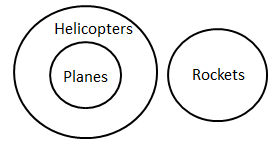
From Venn diagram we can see that neither conclusion I nor conclusion II follows.
22) Answer (C)
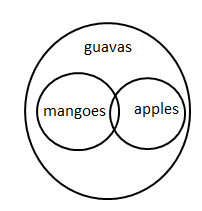
From the venn diagram we can see that both conclusions are possible.
23) Answer (C)
From the Venn diagram, we can see that only we can conclude statement (II) only. (Answer: C)
24) Answer (A)
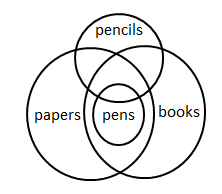
From the venn diagram we can see that only conclusion I follows.
25) Answer (A)
From the venn diagram we can see that only conclusion I follows.
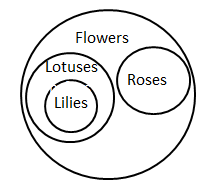


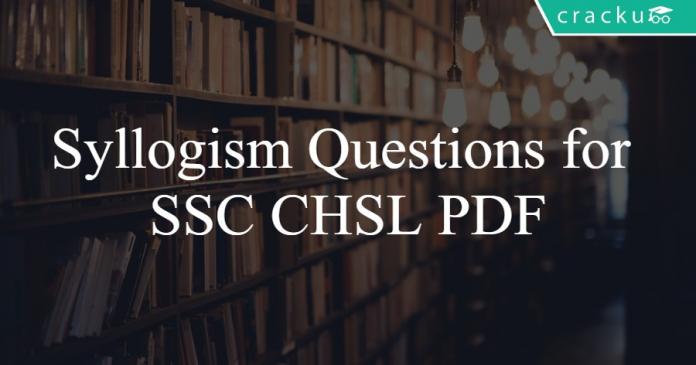



![How To Manage Time In CAT Exam? [Section-wise Tips] How to manage time in CAT exam ?](https://cracku.in/blog/wp-content/uploads/2018/09/fig-03-09-2018_10-54-46-218x150.jpg)